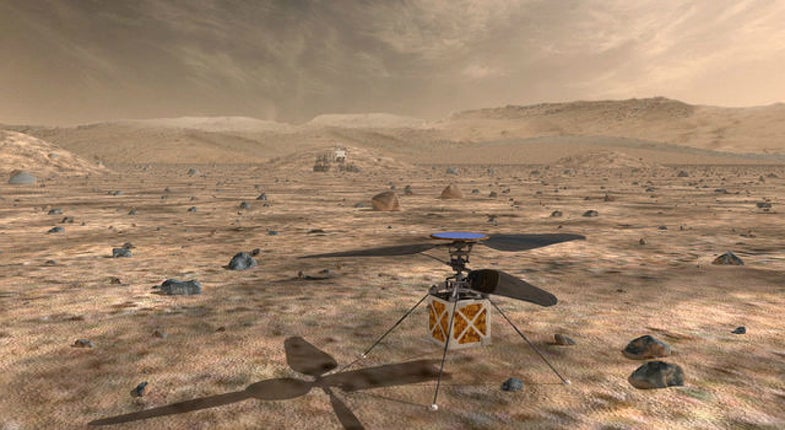NASA just added a tiny autonomous helicopter to its next Mars mission
One small flight for drones

Only 23 of humanity’s 54 missions to Mars have been successful. A whopping 30 either never made it to Mars or failed once they got there, falling short of their exploration goals. The 54th mission, NASA’s InSight lander, is currently en route to the Red Planet and won’t be deemed a success or failure until it lands in November.
A success rate of less than half is grim, especially for multi-million dollar space ventures. But those statistics haven’t stopped us from trying to reach and explore our planetary neighbor, or from attempting more technologically ambitious challenges along the way. Just last week NASA announced its latest Mars experiment: a helicopter that will launch with the Mars 2020 rover in July of the eponymous year. Ultimately, Mars helicopters like this model would be used for scouting, providing more detailed reconnaissance for rovers and, eventually, astronauts, than is possible with orbiters. While an orbiter can see the overall landscape, a flying scout closer to the ground can provide extremely detailed images of the surface from multiple angles, helping to identify future landing or exploration sites or investigating new science targets that show up along the way.
It’s a lofty goal, but to get that additional intelligence, the first step is getting off the ground—and the task of getting a heavier-than-air craft to fly on Mars is monumental.
Helicopters aren’t new technology. Early attempts at helicopter designs date back to the 15th century, when Leonardo da Vinci drew up plans for an “aerial screw,” and flying prototypes blossomed in the 20th century. The first modern helicopter, the VS-300, designed by Igor Sikorsky, made its inaugural flight in Connecticut on September 14, 1939. But, of course, we’ve only designed helicopters to fly here on Earth, and a Mars helicopter is an entirely different beast.

In order to produce lift, rotors spin quickly to move air over the blades: Here on Earth, the record for the highest helicopter flight tops out at around 40,000 feet above sea level. Most helicopters aren’t even capable of that, and can only reach much lower altitudes. Above a certain point, the air becomes too thin to sustain helicopter flight. Mars’ atmosphere is very sparse—about 1/100th the density of Earth’s—meaning that the Mars helicopter will need to fly in atmospheric conditions similar to what you’d find at 100,000 feet above Earth. “Since Mars has a much thinner atmosphere than Earth, the helicopter’s rotors will need to rotate at a much faster speed,” explains Chris Carberry, CEO of Explore Mars, Inc., a non-profit dedicated to the advancement of human exploration of the planet. While Earth helicopters have blades that spin at around 300 rotations per minute (rpm), NASA’s Mars helicopter will have two counter-rotating blades that will reach nearly 3,000 rpm.
Since lift will be difficult to achieve in the low-density atmosphere, the helicopter is tiny, weighing less than four pounds, with a fuselage the size of a softball. So rather than a full-fledged passenger-style helicopter with a human at the helm, it’ll be an autonomous drone. Since we’re several light minutes away from Mars, an Earth-based pilot won’t be able to remotely fly the helicopter in real-time. NASA will simply send a signal to start the mission, and the helicopter will execute its flights on its own, sending back images and data to Earth.
“Like most planetary exploration, Mars exploration overall is moving toward increased miniaturization and autonomy,” says Rod Pyle, a space historian and author who serves as a contractor for NASA’s Jet Propulsion Laboratory,. The research center, also known as JPL, is overseeing the helicopter mission and other robotic exploration missions in the solar system.
“In the future we’ll see many more small drones designed for Mars that will fly out ahead of rovers, probably in swarms, to not only assist in mapping and route planning, like the Mars Helicopter, but also to carry tiny science packages to be able to identify promising targets for a visit by the rover or a mini-rover. They could possibly even land to permit contact science and micro-sampling.” Pyle says.
Before we get to those exciting future helicopter exploration missions, the Mars 2020 rover carrying the helicopter needs to actually land on the planet, which, as we mentioned, isn’t an easy task. “Confidence is high in the main rover because it’s a close cousin to Curiosity,” says Pyle. NASA’s Curiosity rover successfully landed on Mars in 2012. “But the ‘copter is completely new and untried technology,” he notes. “The need to deploy from the rover after a rough-and-tumble entry, descent, and landing is one challenge. The Mars helicopter has to be well-affixed to the rover to reach the ground in good shape.”
If the rover and the helicopter do make it to Mars intact, the rover will deploy the helicopter from its belly pan to the surface, then move away to a safe distance to give the helicopter some space. Solar cells will charge the helicopter’s lithium-ion batteries, and a heating device will prevent it from freezing overnight. On NASA’s command, the helicopter will undergo a 30-day campaign of up to five small test flights, ranging from a 30-second vertical hover to a 90-second flight across a few hundred meters. The distances will be brief and their timing will be quick. At least at first. These small flights, if they’re successful, will open up a new era in Mars exploration. “Imagine having a Mars drone flying down into Valles Marineris, or up Olympus Mons, or into a Martian cave,” says Carberry. “It opens up some amazing possibilities.”